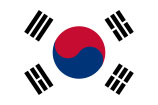|

Flag of South Korea
The flag of South Korea, or Taegeukgi (also spelled Taegukgi in convention) is similar to the Chinese design of the yin and yang symbol and has three parts: a white background; a red and blue taegeuk ("Taijitu" or "Yin and Yang") in the centre; and four black trigrams, one in each corner of the flag.
The four trigrams originate in the Chinese book of I Ching, representing the four Taoist philosophical ideas about the universe: harmony, symmetry, balance, circulation. The general design of the flag also derives from traditional use of the tricolour symbol (red, blue and yellow) by Koreans starting from the early era of Korean history. The white background symbolises "cleanliness of the people." The Taegeuk represents the origin of all things in the universe; holding the two principles of "Yin", the negative aspect rendered in blue, and "Yang", the positive aspect rendered in red, in perfect balance. Together, they represent a continuous movement within infinity, the two merging as one.
Name
Although the revised official Romanisation is Taegeukgi, the word Taegukgi has been used in English-speaking countries historically.
History
The earliest surviving depiction of the flag was printed in a U.S. Navy book Flags of Maritime Nations in July 1882.
The flag was first adopted as a symbol by the kingdom of Korea in 1882. During the Japanese rule of Korea (1910–1945), the flag was banned. The Taegeukgi was used as a symbol of resistance and independence during the Japanese occupation and ownership of it was punishable by execution. After independence, both North and South Korea initially adopted versions of the Taegeukgi, but North Korea later changed its national flag to a more Soviet-inspired design after three years (see article Flag of North Korea).
Specifications
Colours
The official colours of Taegukgi are specified on the "Ordinance Act of the Law concerning the National Flag of the Republic of Korea . There was no specification for shade of colours until 1997, when South Korean government decided to provide standard specification for the flag. On October, 1997, Presidential ordinance on the standard specification of the flag of the Republic of Korea was promulgated, and that specification was acceded by the National Flag Law in 2007.
Errors
The South Korean flag is sometimes drawn differently from the official version. Sometimes the Taegeuki is reversed to make it a taoist Yin-Yang, which traditionally goes clockwise. The gwae may be transposed, possibly in error but possibly because they wish to restore the traditional Asian meanings. South Koreans themselves have different ways of interpreting the traditional symbols.
The text on this page has been made available under the Creative Commons Attribution-ShareAlike License and Creative Commons Licenses
| 